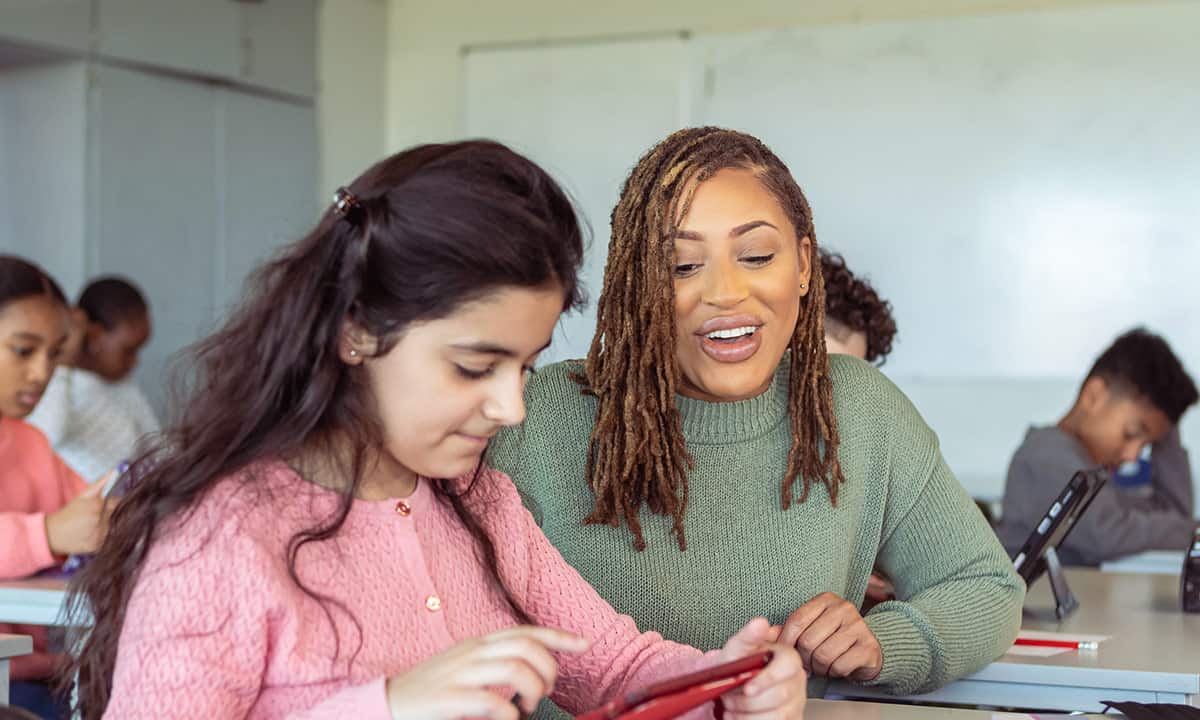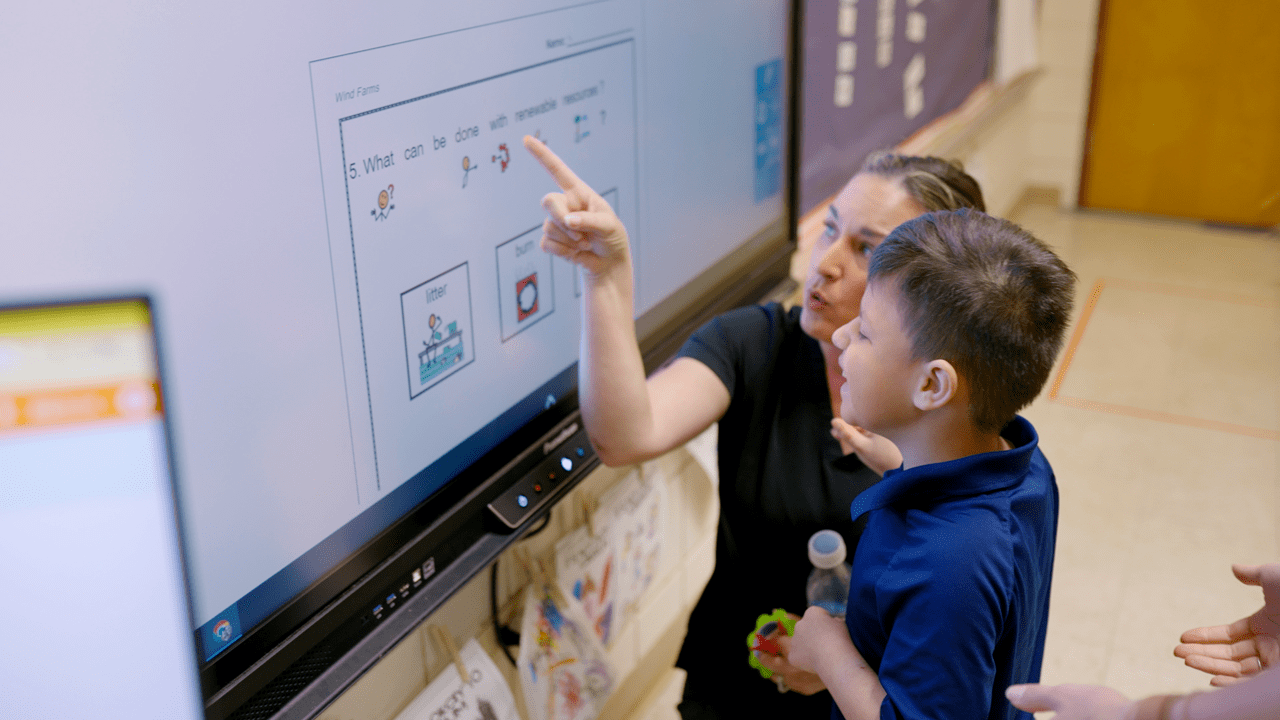The Response to Intervention (RTI) model provides tiers of support, starting with high-quality, evidence-based instruction for all students. If classroom data shows a student isn’t progressing with whole-class instruction, a referral for the next tier of support for more specialized instruction might be warranted. The specialized instruction targets students in areas of need, such as math, reading, and writing. If data continues to show that the student isn’t progressing, they may be referred for more intensive services at the next tier of support.
Tier 1 Response to Intervention
Tier 1 of the RTI model assumes that students are receiving high-quality instruction, so lack of student progress cannot be attributed to poor instruction. Tier 1 support is provided to the entire class, and research should support the effectiveness of the curriculum and instructional methods being used. It’s important to spend significant time and resources choosing a core curriculum and providing professional development to ensure the curriculum is being delivered with fidelity.
Highlights of Tier 1 RTI
- Core reading, writing, and math programs intended for the whole class
- Evidence-based curriculum, materials, and instructional methods
- Reaches a wide range of learners, including:
- Learners with disabilities
- English language learners
- Learners who are gifted and talented
- Allows for differentiation and scaffolding to meet a wide range of learners’ needs
- Uses ongoing assessments to track performance and progress
Tier 2 Response to Intervention
Tier 2 of the RTI model targets small groups of students based on academic data. This data is gathered from various assessments, both formative and summative. Tier 2 interventions must be evidence based and meet the needs of the small group of students who require the additional support. Identified interventions can be teacher-led small groups, participation in a targeted online program, or a combination of both. For many learners, Tier 2 intervention is the support needed to accelerate their learning and continue with grade-level instruction.
Highlights of Tier 2 RTI
- Tier 1 instruction continues to be provided
- Progress monitoring occurs on a regular basis
- Features explicit, systematic instruction, often through the gradual release of responsibility model
- Often provided in a teacher-led small group of 4–6 students or through a targeted online program
- Provides multiple opportunities for practice and feedback
- Other highlights may include:
- Activating prior knowledge
- Guided practice
- Think-aloud structured reading
- Preview/pre-teach
- Book Buddies
- Multiple reading of text for fluency
- Writing conferences with additional support
- Graphic and semantic organizers
- Use of math manipulatives
- Intentional teaching of vocabulary
- Metacognitive strategy instruction
- Concrete-visual-abstract instructional sequence for math
- Peer-assisted learning
Tier 3 Response to Intervention
Tier 3 intervention is highly individualized and intensive. Interventions in Tier 3 may look similar to interventions in Tier 2 but occur at a greater frequency and with a smaller group of students, or one-on-one. At times, a reading or math specialist may deliver Tier 3 interventions to help close learning gaps.
Highlights of Tier 3 RTI
- Provided in addition to Tier 1 instruction and Tier 2 interventions
- The most intensive intervention in terms of frequency and intensity
- Needed for students who require more intensive support and intervention than provided in Tier 2
- May be provided in a teacher-led small-group setting of 2–3 students, a teacher-led individual setting, through a targeted online program, or a combination of those
What RTI Is Not
Response to Intervention is not a specific program; rather, it is an approach that allows teachers to choose what is best for their students’ individual needs. The approach meets the needs of a wide range of learners by being proactive and using data to inform instructional decisions.
Implementation
RTI does not take a wait-and-see approach. This means that trying one classroom-based intervention and then waiting for the end of the grading period to see if the student is progressing is not RTI. Instead, RTI is time oriented and responsive—cycles of interventions may be 4–8 weeks (or shorter or longer depending on the skill being addressed). It is vital that team input be collected and followed up on regularly to ensure students are progressing.
Special Education
Response to Intervention is not a barrier to a special education evaluation. It is always the right of a parent to request that their child be evaluated for special education services at any time before, during, or after the RTI process.
RTI is also not a pre-referral or a replacement for special education services. Students receiving research-based instruction personalized to meet their learning needs are not “in the pipeline” to undergo evaluation for special education services. It is feasible that a special education teacher in an inclusion setting will work with small groups of students who need personalized instruction on the same skill. Some students may have an IEP, and some may not.
Best Practices for RTI
Use evidence-based curriculum and programs: These are crucial qualifiers when choosing any curriculum for Tier 1 instruction or Tier 2 and Tier 3 interventions.
Teacher-led interventions are important: No computer program can replace the human connection. Teachers who lead interventions can lean into relationships, respond to changes in student behavior, and build on student engagement.
Implement interventions with fidelity: Content and processes must be applied as designed, the service must be provided as often as intended, and the setting the intervention was designed for must be used to support intervention fidelity.
Follow the data cycle: Diagnostic assessments determine strengths and areas of growth, inform instruction, and advise differentiated small groupings of students. It is imperative to use daily, weekly, and biweekly formative assessments to adjust lessons and respond to data.
Share data with families and caregivers: If families are informed their child is struggling in a timely manner, this can lead to the best student outcomes possible because families know their learners best and can provide insights into why a student may be struggling or share ways that they support their student at home.
Share data with students: Motivation increases when students understand their abilities and their goals, so provide clear and consistent feedback. This can lead to developing skills in self-advocacy and goal setting.
Collaborate with special education teachers: They are trained to adapt lessons and materials to meet the personalized needs of learners. When general education and special education teachers collaborate, the team has greater problem-solving capacity.
Consider school-wide interventions: Schools that build targeted intervention or targeted enrichment periods into the school day, create summer learning opportunities, and think outside the box to create learning opportunities for students are helping all learners create a strong foundation.
In Closing
The foundation of a strong Response to Intervention framework lies in Tier 1 instruction. Choosing a curriculum that is evidence based and differentiated to meet the needs of a wide range of students is crucial in helping students achieve their highest potential. Tier 2 and 3 interventions impact teachers, students, families, and service providers, to name a few. Well-designed interventions can mean the difference between students who find themselves on solid academic ground once again and those who continue to struggle. The RTI team can significantly impact a student’s future success!


